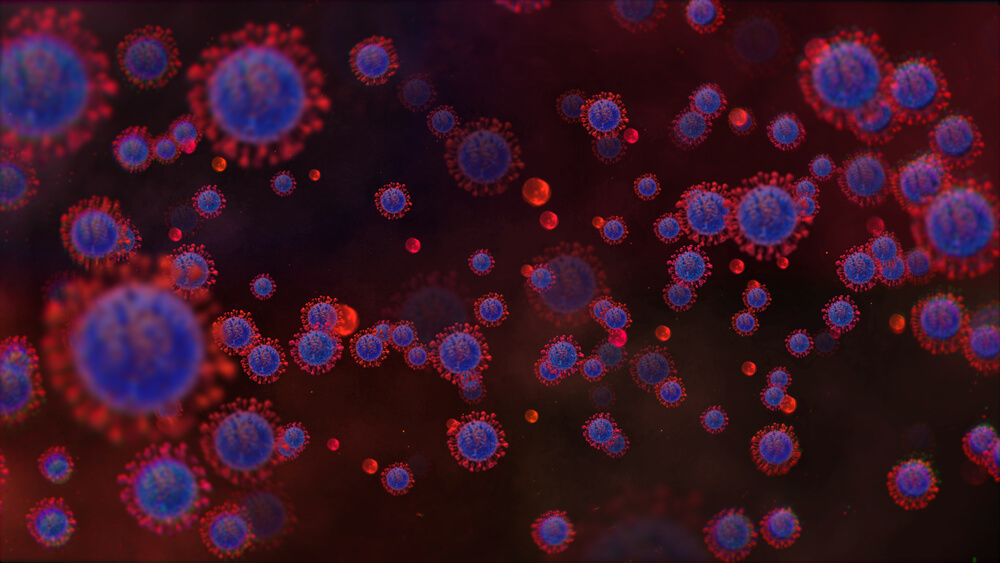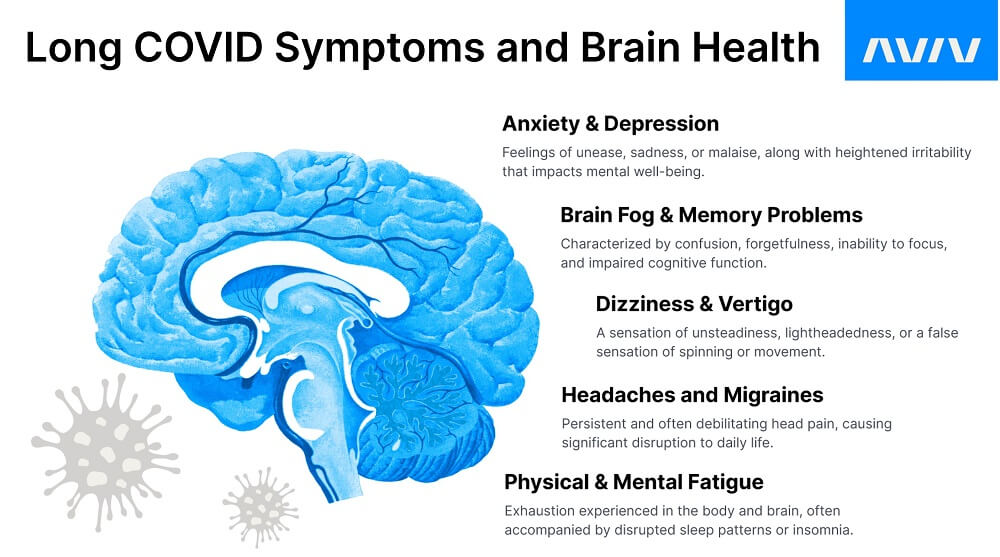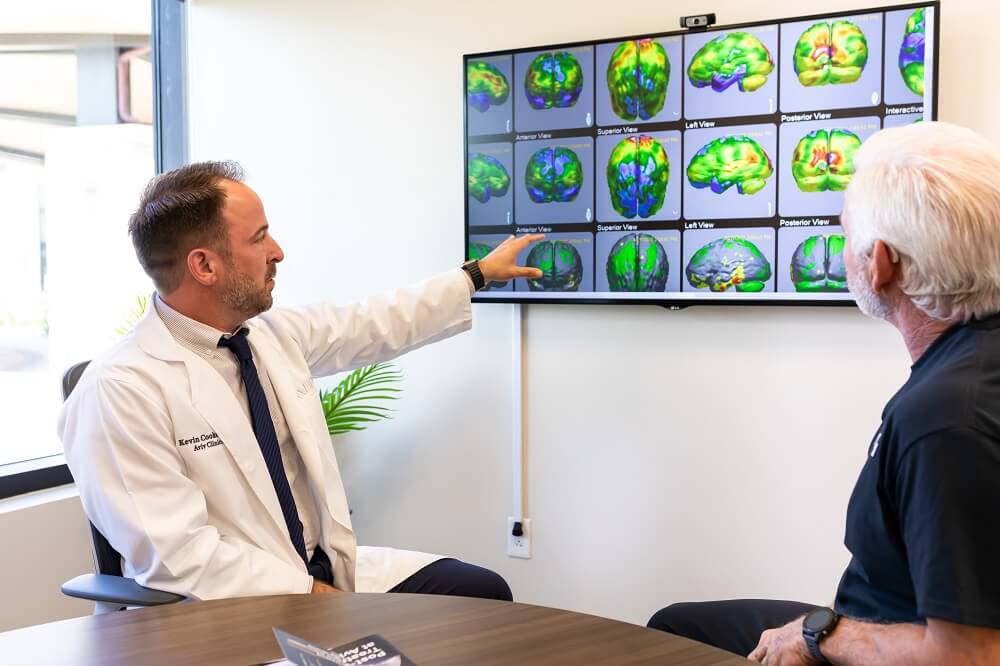
Long COVID Symptom List: What They Are, Why They Persist, and What Helps


Millions of people who tested positive for COVID-19 continue to experience ongoing health issues, clinically known as long COVID. If you’re one of these people, you may experience a range of issues found on the long COVID symptoms list, including fatigue, shortness of breath, brain fog, aches and pains, and other symptoms.
While there is still uncertainty surrounding COVID-19 complications and their long-term side effects, extensive studies offer insight into:
- Post–COVID symptoms
- How long COVID can impact your body and lifestyle
- Treatment methods that can help mitigate long-haul COVID effects
It can be incredibly challenging to navigate these symptoms and find strategies to manage them. Rest assured, there is hope. To help those experiencing long COVID, Aviv Clinics has research-backed information on what the condition entails and what you can do.
What is Long COVID?
Long COVID refers to continuing signs and symptoms that persist, or even develop, after recovering from a COVID-19 infection. In some cases, symptoms may appear to disappear, only to return after a matter of days or weeks.
Below, we detail what long COVID is, how it affects your body, and what you can do to treat it.
As you read through this, keep in mind:
- Each person has a unique experience with COVID-19.
- Therefore, speaking with a doctor is an essential first step.
- Several alternative terms are used for long COVID, such as post-COVID, long-haul COVID, post-acute COVID, and chronic COVID.
How the CDC and WHO Define Long COVID
Throughout the pandemic, these agencies collaborated to monitor and support public health. Based on the list of long COVID symptoms, the CDC and WHO have addressed long COVID as an ongoing health concern:
- The Centers for Disease Control and Prevention (CDC) defines long COVID as a “chronic condition that occurs after SARS-CoV-2 infection and is present for at least 3 months.” They note further that symptoms can last for weeks, months, or years after their first infection.
- The World Health Organization (WHO) defines long COVID as “the continuation or development of new symptoms 3 months after” the acute infection that lat for at least with no other explanation for those symptoms.
Some estimates put the number of people living with long COVID at “65 million individuals worldwide,” with cases increasing daily.
Acute vs. Long-Term COVID Symptoms
Many of the symptoms of an acute COVID infection overlap with common ailments found on the long COVID symptoms list. For a comprehensive understanding of what long-haul COVID is, it’s important to note some differences between acute COVID symptoms and the symptoms of long COVID.
Acute COVID Symptoms
- Acute COVID is the initial phase of a COVID-19 illness, when a person is actively infected with the virus.
- During this phase, people commonly experience respiratory symptoms such as cough, fever, and difficulty breathing.
- Individuals may experience COVID-19 symptoms for up to four weeks, starting from the onset of illness.
- The virus can still be found in the body for up to 12 weeks, with people experiencing subacute COVID symptoms.
Long COVID Symptoms
- Long COVID involves ongoing or new symptoms that continue after an acute COVID infection has subsided.
- Individuals continue to experience COVID-19 symptoms for an average of three months from the onset of illness, sometimes longer.
- Long-haul COVID symptoms may either begin after initial recovery from acute COVID or persist from the initial illness.
- Long COVID symptoms cannot be explained by an alternative diagnosis.
How Common is Long COVID?
In 2021, the WHO released the first clinical definition of long COVID, more than a year after patients coined the term in the face of ongoing symptoms. From nearly the beginning of the pandemic, health organizations studying the virus were seeing long-term side effects and symptoms of impairment from COVID-19 infections.
You aren’t alone if you don’t feel like yourself after having COVID-19. New data suggests that among those who have reported a COVID-19 illness, “nearly one in five (19%)…are currently still having symptoms” months after they first caught the virus.
While many long COVID cases may go undocumented, researchers have estimates for its prevalence:
- Between 10–30% of nonhospitalized cases
- Between 50–70% of hospitalized cases
- Between 10–12% of vaccinated cases
By other estimates, anywhere from “31%–69% of COVID-19 survivors will experience long COVID symptoms after initial recovery.”
Long COVID Symptoms List
By scrutinizing four key areas from the long COVID symptoms list, patients can better understand the symptoms associated with long-haul COVID.
Physical symptoms:
- Fatigue
- Dyspnea (labored breathing)
- Chest pain or tightness
- Cough
- Dysgeusia (loss of taste)
- Anosmia (loss of smell)
- Joint or muscle pain
Cognitive & psychological symptoms:
- Memory decline
- Attention and concentration difficulties
- Brain fog
- Anxiety
- Depression
- Sleep disturbances
- Headaches
- Generalized disabling pain
- Lung symptoms
- Shortness of breath
- Chest pain or tightness
- Vertigo
Cardiac symptoms:
- Myocarditis (inflammation of heart muscles)
- Heart palpitations
- Shortness of breath
- Elevated blood pressure
- Drops in oxygen saturation
Can Long COVID Symptoms Come and Go?
According to current research, yes, long COVID symptoms can come and go over time. Some people may experience periods of improvement, where symptoms lessen or seem to disappear, followed by a relapse or a return of symptoms. In some cases, this relapse can mean a worsening of symptoms. These fluctuations are common in people living with long COVID, with most people reporting “fluctuating (57.7%) or relapsing symptoms (17.6%).”
How Long Until COVID Symptoms Go Away?
The duration of COVID-19 symptoms, in both acute and long-haul cases, vary widely from person to person. Most mild cases resolve within a couple of weeks. Long COVID cases are less predictable. As of now, “more than 200 symptoms have been identified with impacts on multiple organ systems.”
The nature of long-haul COVID, and the way it affects one individual compared to another, suggest that treatment and resolution of symptoms may rely on many personal factors.
If you are experiencing long COVID symptoms, contact our team of certified medical professionals today.
Why Long COVID Symptoms Persist
The persistence of COVID-19 symptoms can be attributed to several factors.
1. Ongoing Inflammation
The initial COVID-19 infection triggers an immune response in the body that results in inflammation. For some people, this immune response continues even after the virus has been cleared.
2. Immune Dysregulation
COVID-19 can affect the immune system long after the initial infection. Long COVID patients can experience immune dysregulation that remains “persistently high at eight months after the infection.”
3. Post-Viral Syndrome
Many viral infections can cause a condition known as post-viral syndrome, which is defined by the presence of persistent symptoms after fighting an infection. This may be the case with the COVID-19 virus.
4. Autoimmunity
Some people may develop an autoimmune response, where the immune system mistakenly attacks healthy cells and tissues. While it’s far from certain, “one theory is that long COVID could be an autoimmune disease” itself.
5. Persistent Viral Presence
Some studies suggest that fragments of the virus can remain in some tissues of the body after recovery of the initial infection. After one year, viral proteins and/or RNA can be found in various bodily systems in some long COVID patients.
Long COVID affects more than just the respiratory system. As stated above, lingering symptoms can affect the cardiovascular, neurological, gastrointestinal, and musculoskeletal systems. Recent research has found that people with long COVID are “at increased risk of a range of cardiovascular disorders,” among other issues.
Of particular concern is the impact of COVID-19 on brain health, specifically because of the presence of many brain-related ailments on the long COVID symptoms list.

Long COVID and Its Effects on Brain and Body
Essentially, COVID-19 impacts the brain. This is why the majority of long COVID symptoms are cognitive and may lead to brain injuries, depending on how severely your body is affected by the virus. According to Dr. Mohammed Elamir, MD, FACP, although there are no patterns between the severity of COVID-19 and the likelihood of experiencing long COVID, there are patterns between:
- Where the virus attacks the brain
- How long COVID symptoms are impacted by that region of the brain
Here are four ways that connection can manifest.
1. Direct Brain Invasion
The COVID-19 virus travels through the nose, into the olfactory sensory neurons, and into the insula, which is located between the frontal and temporal lobes of your brain. The olfactory neurons manage taste and smell, while the insula oversees an “overwhelming variety of functions,” including memory and executive function. Depending on where the virus attacks and the level of damage it creates, an individual may experience prolonged COVID symptoms.
For example, when the virus significantly attacks your olfactory nerves, this may induce a loss of taste and smell. This is why these symptoms are such a strong indicator of the virus.
2. Blood Vessel Injury
Studies show COVID-19 can result in “microvascular injury in the brain.” In other words, it can injure blood vessels that feed blood to the brain. As the virus circulates throughout your bloodstream, the inner blood vessel lining is susceptible to damage. When the inner lining deteriorates, this allows the virus to seep into the tissues or inhibit blood flow to the brain. Both can cause brain injuries. And depending on where those injuries occur, specific brain functions (memory, concentration, etc.) may decline more rapidly than normal.
3. Dysregulated Immune Response
Damage to the inner blood vessel lining can also inhibit the growth of cells, the exact opposite of what our immune system should be doing. Dysregulated immune responses are common, with “marked dysregulation in severe cases” of COVID-19. When the body cannot adequately produce a normal immune response, it either:
- Underreacts to foreign invaders, causing viruses to spread quickly
- Overreacts to foreign invaders, causing the immune system to attack even healthy cells, tissues, and organs
4. Cellular Dysfunction
On a cellular level, COVID-19 can affect metabolic function through the mitochondria. This cell damage slows the body’s response rate to infection, leading to high inflammatory conditions.
How Long Will Patients Have to Deal with COVID Symptoms?
According to Dr. Mohammed Elamir, MD, FACP, the answer isn’t available. But a key guiding factor is the extent of blood vessel damage.
Dr. Elamir explains:
“There’s still a lot to learn about how [mitochondrial dysfunction] will last, but it will probably be tied to the level of microvascular change or blood vessel damage. The more blood vessel damage you have, the more [long COVID symptoms] you’re likely to have. Also, the amount of real estate that those microvascular changes are occupying will probably dictate how long [symptoms] will last.”
WATCH: Long COVID Treatment at Aviv Clinics
How Aviv Clinics Supports Long COVID Recovery
Long COVID is a complex condition with a wide range of symptoms that vary significantly from person to person. That’s why treatment must be just as personalized.
At Aviv Clinics, our medical team takes a highly customized approach to care, starting with a conversation and evolving into a treatment program designed specifically for you.
Because of the complexity of long COVID, it’s important to find a treatment program that:
- Is rooted in data and research
- Offers a comprehensive assessment process
- Connects you with a diverse medical team
While many clinics offer a standard treatment program for long COVID, the Aviv Medical Program is built differently: we begin with a physician-guided evaluation to determine exactly which assessments and therapies are appropriate for your specific symptoms, goals, and medical history.
Depending on your needs, your board-certified Aviv physician will prescribe a personalized treatment program that may include one or more of the following:
- Hyperbaric oxygen therapy using our evidence-based protocol
- Cognitive training
- Physical therapy
- Nutrition coaching
- Neuropsychological support
- Other physician-recommended therapies
The goal is to reduce symptoms, restore cognitive and physical function, and help you feel like yourself again, all with a focus on sustainable improvement and long-term health.
Many individuals with long COVID symptoms, including fatigue, brain fog, memory loss, and cardiovascular complications, have experienced meaningful improvements after completing the Aviv Medical Program.
Watch Danielle’s recovery story to see what’s possible.
Diagnosis and Management of Long COVID
There is no single test that can definitively diagnose long COVID. At Aviv Clinics, your diagnosis starts with a detailed consultation and clinical evaluation by our physicians. From there, we focus on identifying the causes of those symptoms, whether neurological, physical, metabolic, or psychological, and then select therapies that target those mechanisms.
Depending on your symptoms, management strategies may include:
- Cognitive and psychological support to restore brain function and address brain fog, memory loss, anxiety, depression, or emotional strain.
- Physical therapy or physiotherapy to restore stamina, balance, strength, and ability to function daily.
- Nutritional strategies to improve energy and reduce inflammation.
- Targeted symptomatic treatments to address pain, sleep disruptions, or challenges with lung function
- Hyperbaric oxygen therapy delivered with a specific protocol to restore blood flow and oxygen to brain and body tissues
Multiple forms of support can be found through the Aviv Medical Program. Instead of a one-size-fits-all solution, our program relies on a multidisciplinary team that delivers a personalized care plan grounded in science and data.
The Future Outlook for Long COVID Patients
Looking ahead, the future for long COVID patients holds promise. As researchers and medical professionals continue to study the condition and its effects, the medical community gets closer to understanding the mechanisms behind long COVID. New treatment strategies are emerging to target those root causes, rather than masking symptoms.
At Aviv Clinics, our medical team is at the forefront of this research. If you live with symptoms of long COVID, know that recovery is still possible. With the right support and a personalized plan, many patients are reclaiming their cognitive function, energy levels, and quality of life.
Maximize Your Health and Performance with Aviv Clinics
The lasting impacts of COVID-19 don’t have to define your future. Though COVID-19 may have brought ongoing health challenges, the Aviv Clinics team is here to help you and your loved ones get back to optimal health. The Aviv Medical Program delivers a data-driven, personalized protocol to enhance your mind and body and feel like yourself again.
Our team is here to support you every step of the way. Contact our clinic to schedule a free phone consultation and learn whether the Aviv Medical Program is right for you.
Maximizing your health and performance begins with Aviv Clinics.
Last Update: July 16, 2025
The Aviv Medical Program offers a unique opportunity to restore your health and accelerate recovery from Long COVID, helping you regain vitality and cognitive function.







